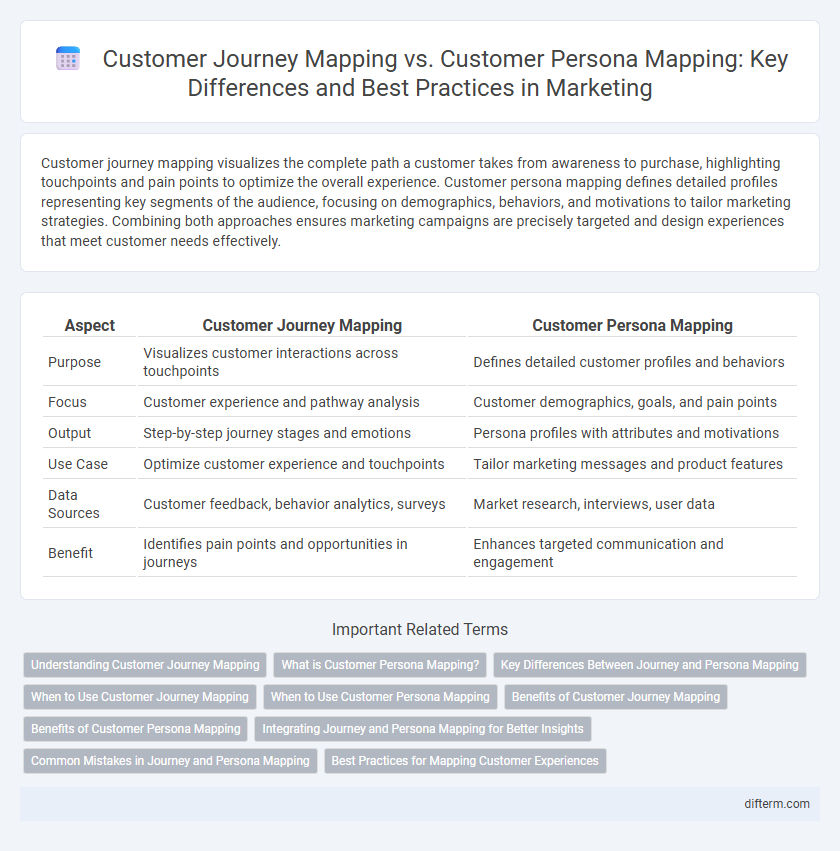Customer journey mapping visualizes the complete path a customer takes from awareness to purchase, highlighting touchpoints and pain points to optimize the overall experience. Customer persona mapping defines detailed profiles representing key segments of the audience, focusing on demographics, behaviors, and motivations to tailor marketing strategies. Combining both approaches ensures marketing campaigns are precisely targeted and design experiences that meet customer needs effectively.
Table of Comparison
| Aspect | Customer Journey Mapping | Customer Persona Mapping |
|---|---|---|
| Purpose | Visualizes customer interactions across touchpoints | Defines detailed customer profiles and behaviors |
| Focus | Customer experience and pathway analysis | Customer demographics, goals, and pain points |
| Output | Step-by-step journey stages and emotions | Persona profiles with attributes and motivations |
| Use Case | Optimize customer experience and touchpoints | Tailor marketing messages and product features |
| Data Sources | Customer feedback, behavior analytics, surveys | Market research, interviews, user data |
| Benefit | Identifies pain points and opportunities in journeys | Enhances targeted communication and engagement |
Understanding Customer Journey Mapping
Customer journey mapping visualizes the step-by-step interactions a customer experiences with a brand across multiple touchpoints, highlighting pain points and opportunities for engagement. Understanding customer journey mapping enables marketers to tailor strategies that improve user experience and increase conversion rates by addressing specific moments in the buyer's path. Unlike customer persona mapping, which focuses on demographic and psychographic profiles, customer journey mapping emphasizes the dynamic process of decision-making and customer behavior over time.
What is Customer Persona Mapping?
Customer persona mapping involves creating detailed profiles representing ideal customers based on demographics, behaviors, motivations, and pain points to tailor marketing strategies effectively. It helps businesses understand distinct customer segments and predict their needs, enabling personalized content and targeted campaigns. Unlike customer journey mapping, which focuses on the steps customers take, persona mapping centers on the customer's identity and characteristics to optimize engagement.
Key Differences Between Journey and Persona Mapping
Customer journey mapping outlines the step-by-step experiences and touchpoints a customer encounters during interactions with a brand, emphasizing behavior and emotions over time. Customer persona mapping focuses on detailed profiles that represent target audience segments, highlighting demographics, motivations, and preferences to tailor marketing strategies. The key difference lies in journey mapping's dynamic process-oriented perspective versus persona mapping's static, archetype-based insights for strategic targeting.
When to Use Customer Journey Mapping
Customer journey mapping is best used when businesses need to understand the step-by-step interactions customers have with their brand across multiple touchpoints, allowing marketers to identify pain points and optimize the overall experience. It is ideal for complex buying processes, such as B2B sales or high-involvement consumer purchases, where detailed insights into customer behaviors and emotions at each stage help improve conversion rates. Unlike customer persona mapping, which focuses on defining target audience segments, customer journey mapping emphasizes the dynamic experience and decision-making flow throughout the lifecycle.
When to Use Customer Persona Mapping
Customer persona mapping is ideal when businesses need to develop targeted marketing strategies by understanding specific customer demographics, motivations, and pain points. It works best during the early stages of product development or campaign planning to tailor messaging that resonates with distinct audience segments. Use customer persona mapping to create personalized content and improve customer engagement by addressing unique behavioral patterns.
Benefits of Customer Journey Mapping
Customer journey mapping provides a detailed visualization of each touchpoint a customer interacts with, enabling marketers to identify pain points and enhance user experience effectively. It allows for data-driven decision-making by tracking customer behaviors and emotions throughout the purchasing process, leading to increased customer retention and satisfaction. This method offers actionable insights that drive personalized marketing strategies and improve overall conversion rates compared to static customer persona mapping.
Benefits of Customer Persona Mapping
Customer persona mapping delivers deep insights into target audiences by creating detailed profiles that reflect customers' demographics, behaviors, and motivations, enabling highly personalized marketing strategies. It enhances segmentation accuracy and content relevance, driving higher engagement and conversion rates across channels. Businesses leveraging persona mapping experience improved customer satisfaction and loyalty, as campaigns resonate more authentically with distinct audience needs.
Integrating Journey and Persona Mapping for Better Insights
Integrating customer journey mapping with customer persona mapping provides deeper insights into user behaviors and motivations by aligning emotional touchpoints with demographic data. Combining these strategies enables marketers to tailor personalized experiences at each phase of the buying cycle, enhancing engagement and conversion rates. Leveraging integrated maps supports data-driven decisions that optimize marketing campaigns and improve customer satisfaction metrics.
Common Mistakes in Journey and Persona Mapping
Common mistakes in customer journey mapping include oversimplifying touchpoints, ignoring emotional responses, and failing to integrate real customer data, which leads to inaccurate representations of customer experiences. In customer persona mapping, errors often involve creating generic personas without detailed demographic or behavioral insights and neglecting to update personas based on evolving customer trends. Both practices suffer when teams overlook cross-channel interactions and customer motivations, resulting in ineffective marketing strategies.
Best Practices for Mapping Customer Experiences
Customer journey mapping focuses on visualizing every touchpoint a customer interacts with, revealing pain points and opportunities for improvement across channels. Customer persona mapping emphasizes defining detailed profiles of target audiences, highlighting demographics, behaviors, and motivations to tailor messaging effectively. Best practices include integrating data from multiple sources, involving cross-functional teams, and continuously validating maps with real customer feedback to ensure accuracy and relevance.
Customer journey mapping vs customer persona mapping Infographic

 difterm.com
difterm.com